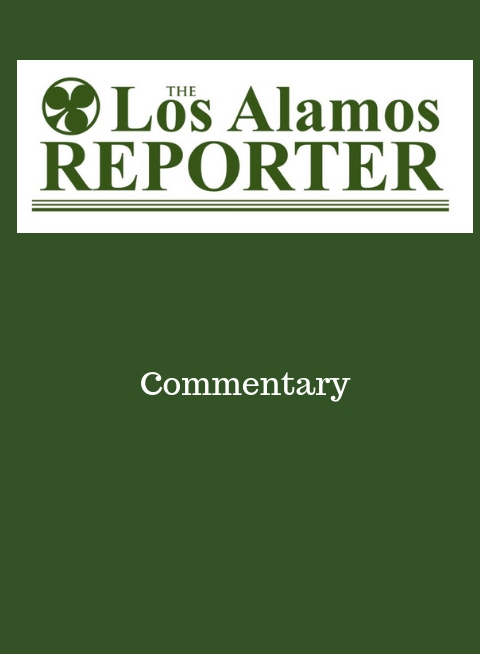 BY DR. VIRGINIA NECOCHEA & CHARLES DE SAILLAN
BY DR. VIRGINIA NECOCHEA & CHARLES DE SAILLAN
Tritium is a radioactive isotope of hydrogen. It emits beta radiation, which can be very dangerous if inhaled. Like other forms of ionizing radiation, tritium can cause cancer, genetic mutations and birth defects, and assorted other adverse health effects.
So it is not surprising that many people were dismayed when they learned that the U.S. Department of Energy (DOE) and its contractor at Los Alamos National Laboratory plan to release 114,000 curies of tritium gas into the atmosphere at Technical Area 54 and, possibly, at Technical Area 16. DOE has been storing this waste tritium in four steel canisters at TA-54 at the Laboratory for more than a decade. Over time, pressure has built up in the canisters, which DOE plans to relieve by venting the tritium gas into the atmosphere.
DOE has assured the public that the venting will be “safe.” According to DOE, Laboratory engineers have devised a filtration system to capture “most of the gas” and the venting will be carefully monitored. If the released tritium reaches 80 percent of the regulatory limit, the venting operation will be shut down. The highest possible off-site radiation dose from venting the tritium is 20 millirem. What could possibly go wrong?
Actually, several things.
First. DOE is not certain how effective its filtration system will be. In its submission to the U.S. Environmental Protection Agency (EPA), DOE’s contractor states vaguely that the filtration system will remove a “significant portion” of the tritium. Its estimate of the removal rate of the filtration system varies widely from 20 percent to 90 percent of the vented tritium. The remaining 10 percent to 80 percent of the tritium would escape into the atmosphere. The filtration system, moreover, is not an EPA-approved pollution control technology.
Second, after venting the canisters at TA-54, DOE plans to move them to TA-16. DOE acknowledges that “jostling” the canisters while handling and transporting them may cause more tritium gas to build up pressure within the canisters, necessitating additional venting. Such venting would take place more or less spontaneously, in a parking lot or on the side of the road, with unpredictable results.
Third, while DOE assures the public that a maximum radiation dose of 20 millirem will not be exceeded as a result of the venting, that dose is actually twice the maximum permissible dose set by EPA for an entire year. EPA’s maximum permissible dose is 10 millirem per year above background. But even a dose of 10 millirem poses some risk. According to the National Academy of Sciences, there is no “safe” level of radiation exposure. The carcinogenicity of tritium and other radiation exhibits a “zero threshold” dose-response relationship, meaning that even a very small dose produces a corresponding risk of cancer.
DOE points out, by way of comparison, that the background radiation level in northern New Mexico is approximately 350 to 400 millirem per year. That background level is mostly solar radiation. The cancer risk from solar radiation is largely unavoidable. But we wear hats and sunglasses, and we apply sunblock, to limit the risk from this radiation as much as we can. And despite these precautions, roughly 50 New Mexicans die each year from skin cancer, mostly due to exposure to solar radiation.
Given these facts, DOE’s assurances that the venting will be “safe” are not particularly convincing. Furthermore, DOE (and its predecessor agency the Atomic Energy Commission) has a long history of assuring the public that various radiation exposures are “safe” when in reality they are not. For example, government agencies failed to warn the uranium miners in northwestern New Mexico, most of them Native Americans, of the dangers from inhaling uranium dust. Many died of lung cancer. The AEC assured the “downwinders” who lived near the Nevada test site that the above-ground nuclear tests conducted in the 1950s and 1960s were “safe.” And again, thousands of the downwinders developed cancer from nuclear fallout. DOE’s credibility on the safety of public exposure to ionizing radiation is next to non-existent.
As is often the case, the potential harmful health effects of the tritium venting are likely to fall disproportionately on the nearby Pueblos: San Ildefonso Pueblo, Santa Clara Pueblo, Jemez Pueblo, and Cochiti Pueblo. The environmental injustice posed to frontline communities that would result from releasing radioactive tritium into the atmosphere at the Laboratory cannot be ignored.
We believe that DOE should conduct an analysis of alternatives for the disposition of the waste tritium. Alternatives to releasing tritium into the atmosphere may be more costly, but cost should not be a determining factor. We are confident that the scientists and engineers at the Laboratory are capable of developing reasonable alternatives that would not release any tritium into the atmosphere.
Public Meeting: DOE will be holding a virtual public meeting (via WebEx) on the planned tritium venting on November 5, 2020, from 5pm to 7pm Mountain Time. We encourage interested members of the public to attend the meeting and speak out in opposition to the venting. The WebEx Event meeting password is vG9Rbr3m3f4. Those who do not have internet access may call in by phone at 415-655-0001, access code 173 622 0434. If joining by phone, the meeting password is 84972736. Anyone interested in attending or speaking at the public meeting should register on-line at the following web address:
https://www.lanl.gov/environment/flanged-tritium-waste-containers.shtml
Virginia Necochea is Executive Director of New Mexico Environmental Law Center, a non-profit public interest law firm based in Santa Fe, N.M. Charles de Saillan is a Staff Attorney at the New Mexico Environmental Law Center.
